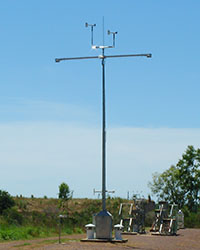Atmospher Sci & Global Chg
Research Highlights
January 2018
How Many Weather Stations Are Enough to Accurately Simulate Building Energy Demand?
PNNL researchers found that using fewer stations in models led to larger biases.
 Surface meteorological stations obtain statistics of surface wind speed, wind direction, air temperature, relative humidity, barometric pressure, and rain rate. Photo from the Atmospheric Radiation Measurement (ARM) Climate Research Facility, a U.S. Department of Energy scientific user facility
Surface meteorological stations obtain statistics of surface wind speed, wind direction, air temperature, relative humidity, barometric pressure, and rain rate. Photo from the Atmospheric Radiation Measurement (ARM) Climate Research Facility, a U.S. Department of Energy scientific user facility
The Science
To estimate building energy demand by region, researchers typically use data from a limited number of "representative" weather stations for their model simulations. This reduces computational costs in order to make simulations easier to manage, but at the expense of capturing the full spatial complexity of weather variations or climate trends. Researchers at the U.S. Department of Energy's Pacific Northwest National Laboratory developed a unique analytical approach to quantify potential biases in temperature and electricity demand to inform future decisions balancing this tradeoff.
The Impact
In this paper, researchers explored the tradeoffs and biases associated with using different numbers of representative weather stations to simulate building energy demand across the Western U.S. electric grid. The results will help guide future energy demand simulations, which are important for understanding the complex interactions among weather, energy, water, and other human and natural systems. The approach might also transfer to other sectors that rely on weather information to drive numerical simulations at high spatial resolution across broad regions.
Summary
Scientists use numerical building simulations for a wide variety of applications, such as assessing building codes and standards, or projecting future energy demand changes under different climate and building technology scenarios. A key aspect of designing these simulations is selecting the number and location of weather stations used to force the models. Researchers calculated the temperature and corresponding electricity demand errors associated with using as few as eight and as many as 150 weather stations across the Western United States. In a model setup using only eight weather stations and 10,000 unique buildings, 220,000 total simulations are required. This is a fraction of the more than 2 million simulations necessary for a setup using all available weather stations.
Researchers calculated temperature errors relative to four years of high-resolution temperature reanalysis data. They based load errors on empirical temperature-load relationships derived from a calibrated simulation of building energy demand in the Western U.S. using PNNL's Building ENergy Demand (BEND) model. Using only eight stations resulted in an average absolute summertime temperature bias of approximately 4.0°C, compared to about 1.5°C when 150 stations were used. Temperature biases of this magnitude could translate to mean summertime simulated energy demand biases as high as 13.5 percent and peak demand biases of 20-40 percent-a significant error for capacity expansion planners who might use these types of simulations. Researchers also found that increasing the size of the domain reduced the magnitude of the biases, as positive and negative biases might cancel out, and that using weather stations close to population centers reduced both mean and peak load biases.
Acknowledgments
Sponsors: The U.S. Department of Energy Office of Science, Biological and Environmental Research supported this research as part of the Integrated Assessment Research program through the Integrated Multi-sector, Multi-scale Modeling (IM3) Scientific Focus Area.
Research Area: Climate and Earth Systems Science
Research Team: Casey D. Burleyson, Nathalie Voisin, Z. Todd Taylor, Yulong Xie, and Ian Kraucunas, PNNL
Reference: C.D. Burleyson, N. Voisin, Z.T. Taylor, Y. Xie, I. Kraucunas, "Simulated Building Energy Demand Biases Resulting from the Use of Representative Weather Stations." Applied Energy 209, 516-528 (2018). [DOI: 10.1016/j.apenergy.2017.08.244]
